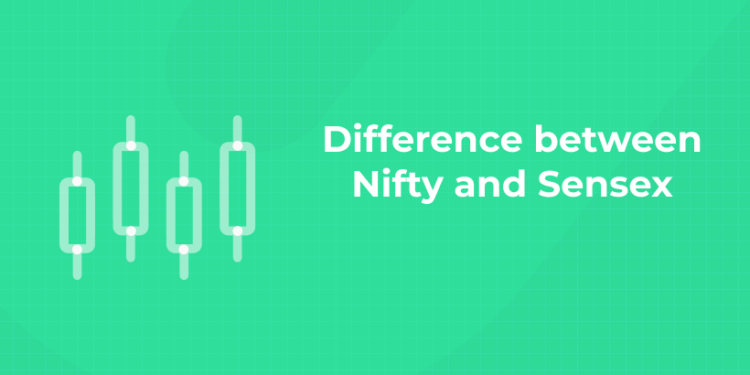Table of Contents
The Stock Exchange of India has more than 7,000 listed companies. For the average trader or investor, it is almost impossible to follow all these companies to understand the movements of the market. That’s why there are Nifty and Sensex, two stock indices made up of selected listed companies that represent the entire market. They help us determine market performance and understand the overall economy.
Let’s understand the specifics of these two indexes and learn the difference between Nifty and Sensex.
What is a Stock Index?
A stock index is a measure of the overall performance of the stock market. An index that selects a sample of listed companies covering a variety of sectors and industries acts as a proxy.
So when we need to understand the direction of the market, let’s look at these market indicators. They indicate market behavior or investor sentiment. The upward movement of the indicators indicates an uptrend while the downward movement indicates a downtrend.
Click here to learn more about the Entri online stock trading course!
What is Sensex?
Known as the Sensitive Index, the Sensex is a stock market index of the Bombay Stock Exchange (BSE). With an underlying value of 100, Sensex is a market-weighted stock index that includes the stocks of the top 30 reputable companies, based on their financial strength and performance. Additionally, Sensex is calculated using the free-float market capitalization method, and the performance of 30 selected stocks is directly reflected by the index grade.
The percentage of all shares issued by companies that are available to the public to trade in the market is known as the freely transferable market capitalization. In the free-floating market capitalization method, the market value of all 30 stocks selected, relative to a reference period, is reflected by the index. Sensex is calculated first by determining the market capitalization of each of the 30 companies, and then multiplying it by a free-floating coefficient, providing a free-floating market capitalization. It is then divided by the index divisor.
What is Nifty?
National Stock Exchange Fifty (Nifty) is the stock market index of the National Stock Exchange (NSE). Also known as NIFTY 50 and CNX Nifty, it consists of 50 stocks that are actively traded on the NSE and are owned and managed by India Index Services and Products Ltd. (IISL), a subsidiary of NSE.
In addition, the underlying value of the index is 1,000 and it is calculated using the free-floating market capitalization weighting method. Similar to Sensex, the first market capitalization is calculated by multiplying equity by the market price. To determine the floating cap, equity is multiplied by the price and again it is multiplied by the IWF (Investigated Weight Factor). Nifty is then calculated daily, by dividing the current market value by the underlying market cap and multiplied by the base index value of 1000.
Difference between Nifty and Sensex
Sensex
- The Sensex is the benchmark index of the Bombay Stock Exchange.
- Being introduced in 1986
- it is the oldest stock index in India
- Sensex is an amalgamation of the words `sensitive` and `index`.
- The index comprises the top 30 listed companies in the BSE.
- The stock index features companies across as many as 13 different sectors.
- The base value that’s utilized for the calculation of the index is 100.
- The base year that’s considered for the calculation of Sensex is 1978-1979.
Nifty
- Nifty is the benchmark index of the National Stock Exchange.
- Introduced in 1996, the Nifty is a relatively new stock market index.
- Nifty is a combination of the words “country “ and”fifty “.
- This index includes the top 30 listed companies in the BSE.
- On the other hand, Nifty is broader and has companies from 24 different industries.
- The base value that ‘is utilized for the calculation of the index is 1000.
- The base year that’s considered for the calculation of Nifty is 1995.
How to Calculate Sensex and Nifty?
1: What is a stock?
We now know the basic differences between Sensex and Nifty, but how do you calculate them manually? This involves simple calculations, which makes it easy for you to understand the market trends.
Want live trading support to boost confidence? Join Entri’s online stock trading course!
How to Calculate Sensex?
Sensex or sensitive Index is calculated based on the free-float capitalization of all the 30 companies and the base value of Sensex.
Here is a step-by-step process on how to calculate the Sensex –
-
- The market capitalization of 30 companies is calculated.
- The free Float capitalization of all the companies is estimated and added together to get the total free-float capitalization value.
- Apply the Sensex formula,
Sensex formula = (Free float market capitalization of 30 companies / Base market capitalization) * Base value of the Index.
- The Sensex value is calculated.
How to Calculate Nifty?
Nifty or National Fifty is calculated based on the free float capitalization-weighted method of all the 50 companies. The price of the Index reflects the total market value of all the stocks in the Index relative to the base period on November 3rd, 1995.
Market Capitalization = Current market price * outstanding shares.
The aggregate market capitalization of each scrip in the Index during the base period is the Index’s base market capitalization. During the base period, the market capitalization is equated to an index value of 1000, which is known as the base index value.
Free Float Market Capitalization = Shares outstanding * Price * Investable Weight Factors (IWF)^
Index Value = (Current Market Value / Base Market Capital) * Nifty Base Index Value (1000)
Stock Market Training Reviewed & Monitored by SEBI Registered RA
Trusted, concepts to help you grow with confidence. Enroll now and learn to start investing the right way.
Know moreFrequently Asked Questions
Q1. Which is older, the Sensex or the Nifty?
Ans: Sensex is older than Nifty and has outperformed it despite the fact that Nifty has more companies.
Q2. What are Nifty and Sensex in simple words?
Ans: Nifty and Sensex are benchmark index values for measuring the overall performance of the stock market. Nifty is the Index used by the National Stock exchange, and Sensex is the Index used by the Bombay Stock Exchange.
Q3. What is the basic difference between Sensex and Nifty?
Ans: The basic difference between Sensex and Nifty is the number of companies that are grouped as a sample. Sensex considers 30 companies for sampling, while Nifty considers 50 companies.












